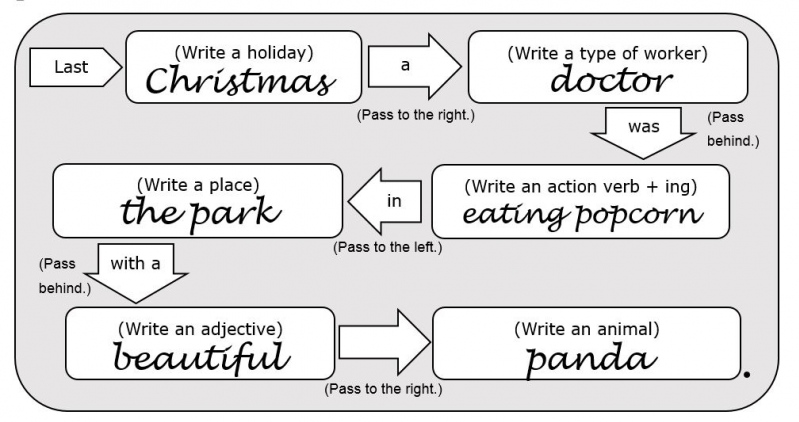|
| |
Sentence Writing with Classroom CooperationCameron S. Nitta Young ESL learners can often find grammar practice challenging and boring. Therefore, activities that inspire originality can excite students to tackle new grammar from their lessons. This activity was designed to review grammar points while providing students opportunities to share their creativity with their classmates.
Students will be asked to choose different vocabulary words needed to fill-in the blanks in a sentence that reflects their target grammar point, similar to a madlibs activity. However, students will not choose the words for their own worksheet, but rather will be writing on their neighbors’ worksheets. Students must then test their understanding of the sentence by drawing a picture that best represents its meaning. Finally, students will have the opportunity to share their work with the teacher or neighbors to get feedback. To begin this activity, teachers may wish to provide their students with a list of vocabulary words, depending upon the learners’ level. Teachers may also wish to review the grammar structure if it was introduced recently. In this sample activity, after receiving their worksheets, students should choose a holiday for the first category. Teachers may encourage learners from different backgrounds to include holidays specific to their cultures, thereby introducing new holidays to the class.  Figure 1. Fill-in-the-blank sentence After filling-in their holiday, students should pass their papers to the neighbor on their right. On the new paper they are given, students will fill-in the next box with a type of worker, for example police officer, firefighter, cook, etc. Students will then pass their papers to the student behind them who will then choose an action verb. Papers will then be passed to the left where they will choose a place. Next, students will pass their papers again to the person behind them where they will write an adjective. The categories from worker to adjective are opportunities to review key terminology or encourage students to use challenging vocabulary recently learned. Finally, students will pass their papers to the right where they will choose an animal. Here again, teachers may wish to encourage students to choose animals that are special to their cultures like a Japanese tanuki or Hawaiian nene bird.  Figure 2. Combine the words into a sentence Papers will then be returned to the original owners. Students must then combine the words with the given grammar structure into a complete sentence. Once the sentence is written, students will show their understanding of the sentence by drawing a picture reflecting the meaning. Here, teachers should encourage students to collaborate together in the case that one student provided an animal that is culturally specific or unfamiliar to the drawer. This cultural partnership can encourage students to learn from each other, shifting the focus away from teacher centered learning to peer learning. Once pictures are completed, students should be encouraged to share their work with a peer or the teacher to receive feedback. Encourage students to give feedback on how interesting or amusing the sentence is to the reader. In beginner level classes that have no experience with feedback, teachers may instruct students to share their work in a mini presentation. The listener would then give verbal comments and sign the reader’s paper. Peer sharing with feedback and presentations can encourage students to practice English while building a positive learning environment.  This lesson is ideal for teachers who require a level of flexibility in lessons. Because the categories and sentences can accommodate any grammar, it can be used for any level of learner. For instance, if the focus is on parts of speech, the activity can be simplified down to only asking for the two word combinations and mini-drawings.  The flexibility this lesson provides teachers and the opportunities it creates for creative expression makes it a meaningful tool in ESL classrooms. By incorporating outlets for students to use English in creative and fun ways, teachers can energize their learners while creating positive learning environments. Cameron S. Nitta has been teaching English in a Japanese public high school in the Ibaraki prefecture for about 5 years.  | |
| ITBE Link - Spring 2016 - Volume 44 Number 1 |